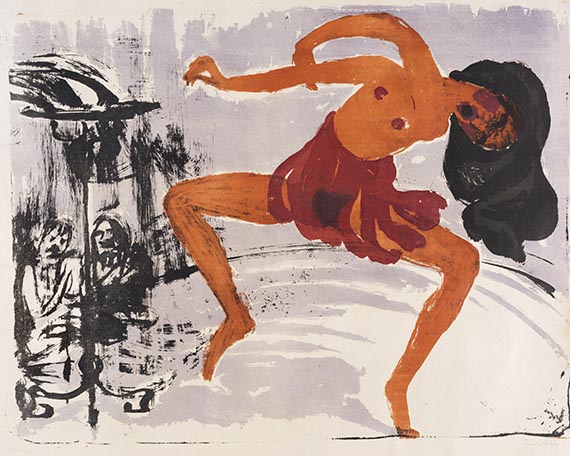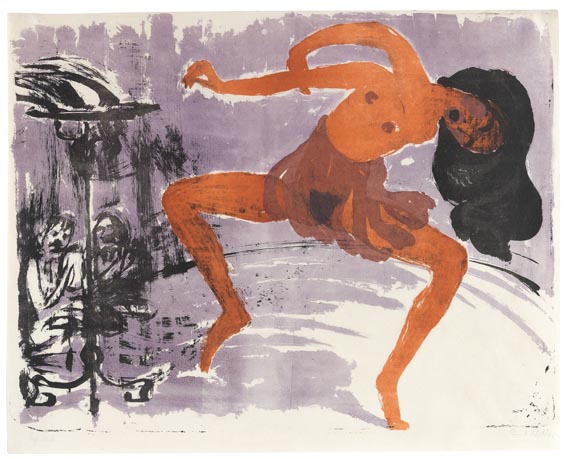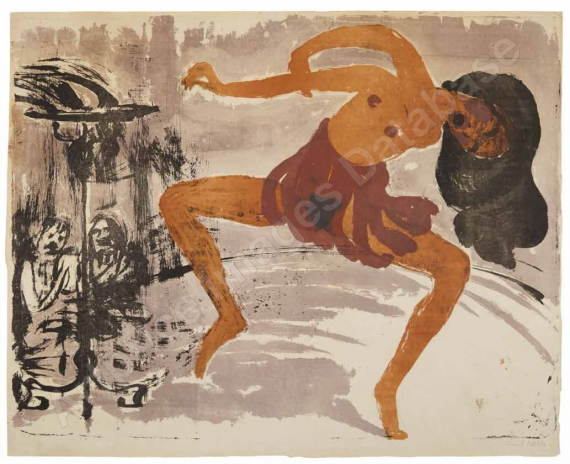Sale: 550 / Evening Sale, June 07. 2024 in Munich  Lot 124000443
Lot 124000443
 Lot 124000443
Lot 124000443
124000443
Emil Nolde
Tänzerin, 1913.
Lithograph in 5 colors
Estimate:
€ 120,000 - 140,000
$ 128,400 - 149,800
Information on buyer's premium, taxation and resale right compensation will be available four weeks before the auction.
Tänzerin. 1913.
Lithograph in 5 colors.
Signed and inscribed "Probedruck Tänzerin". Trial proof aside from the edition. On wove paper (Reverse side of a template with the typographical designation “Schmarje Wandtafel A 8, Verlag v. Aug.Westphalen, Flensburg"). 52 x 67 cm (20.4 x 26.3 in). Sheet: 57,2 x 72,1 cm (22,5 x 28,3 in).
[EH].
• Expressionism at its best: an ecstatic demonstration of pure passion.
• The “Dancer” is one of Emil Nolde's best lithographs; it is one of the most fascinating graphic works of Expressionism.
• One of the most expressive and liberated figures in Nolde's graphic oeuvre.
• Rare trial proof in this color variant.
• Gustav Schiefler emphasized the wild and eccentric movement in this sheet.
PROVENANCE: Private collection North Rhine-Westphalia (in second generation).
LITERATURE: Gustav Schiefler, Christel Mosel, Martin Urban, Emil Nolde – Das graphische Werk, vol. II: Holzschnitte, Lithographien, Hektographien, Cologne 1996, no. L 56 (illu.).
"The dancer, the last of the sheets, was to express passion and my joy"
Emil Nolde
Lithograph in 5 colors.
Signed and inscribed "Probedruck Tänzerin". Trial proof aside from the edition. On wove paper (Reverse side of a template with the typographical designation “Schmarje Wandtafel A 8, Verlag v. Aug.Westphalen, Flensburg"). 52 x 67 cm (20.4 x 26.3 in). Sheet: 57,2 x 72,1 cm (22,5 x 28,3 in).
[EH].
• Expressionism at its best: an ecstatic demonstration of pure passion.
• The “Dancer” is one of Emil Nolde's best lithographs; it is one of the most fascinating graphic works of Expressionism.
• One of the most expressive and liberated figures in Nolde's graphic oeuvre.
• Rare trial proof in this color variant.
• Gustav Schiefler emphasized the wild and eccentric movement in this sheet.
PROVENANCE: Private collection North Rhine-Westphalia (in second generation).
LITERATURE: Gustav Schiefler, Christel Mosel, Martin Urban, Emil Nolde – Das graphische Werk, vol. II: Holzschnitte, Lithographien, Hektographien, Cologne 1996, no. L 56 (illu.).
"The dancer, the last of the sheets, was to express passion and my joy"
Emil Nolde
Dance as emotional expression
Emil Nolde revered dance as one of the few forms of expression entirely subject to impulsive emotion. He painted the exuberant “Wild tanzende Kinder" (Children Dancing Wildly) as early as in 1909, a year later made the ecstatic "Tanz um das Goldene Kalb" (Dance around the Golden Calf). In his painting “Kerzentänzerinnen" (Candle Dancers) from 1912, elements of exhilaration and ecstasy become particularly evident. Elements that also characterize our rare color lithograph "Tänzerin" (Dancer). Nolde, who was actually a rather reserved man from the north, did not view dance in a classical sense of physical mastery, what he liked about it was its and archaic and primal form of expression. His dancers are no longer of this world. They embody the transition into a sphere of the supernatural that excludes all human rationality. Nolde's “Tänzerin" is one of the most liberated figures in Nolde's graphic oeuvre.
In addition, the erotic element, which this color lithograph specifically addresses, is an important component that Nolde deliberately brought into play here. Even in the years before his South Seas voyage of 1913-1915, Nolde was interested in the indigenous cultures of the South Seas, a contemporary trend. This “Tänzerin" demonstrates that this did not remain without influence on his later works.
Nolde discovered color lithography in 1913
Nolde's first lithographs were drawings he transferred onto the lithographic stone using transfer paper. This process used lithography solely as a medium of reproduction, as was common practice at the time in poster printing, for example. It was only at Gustav Schiefler's suggestion that he began to draw directly onto the lithographic stone in 1911, which enabled him to to render his artistic intention directly onto the stone. However, these early lithographic sheets were printed in only one color, usually black or black-brown. It was not until 913, that he discovered the full potential of color lithography at August Westphalen's Flensburg studio, the place where he created this masterpiece.
During his eight-week collaboration with August Westphalen, Emil Nolde created his finest lithographs, which today count among the most important works of Expressionist graphic art. In the second volume of his memoirs “Jahre der Kämpfe" (Years of Struggle), the artist reveals that it was only there that he found out that lithography was more than just a method of reproducing drawings on paper. Instead, he discovered the artistic freedom that drawing directly on the lithographic stone offered the artist. “The painter can only experience the technique's charm and its potential when he works right on the stone. [..] and I stood there constantly drawing, etching, grinding, mixing, weighing, switching between colors and hues and bringing out the large pictures from the press, almost all of them in the most diverse nuances and states. It was a pleasure and a great joy for me.. “ (E. Nolde, Jahr d. Kämpfe, Cologne 1967, p. 261).
“Tänzerin" is regarded Nolde's most accomplished achievement in the field of printmaking. In his book “Meine Graphik Sammlung”, Gustav Schiefler expressly regrets that he was unable to acquire a copy of it.
The present proof was executed on the reverse of a template sheet that was also printed in August Westphalen's workshop. A proof printed on such a kind of paper is also in possession of the Ada and Emil Nolde Foundation in Seebüll.
Emil Nolde revered dance as one of the few forms of expression entirely subject to impulsive emotion. He painted the exuberant “Wild tanzende Kinder" (Children Dancing Wildly) as early as in 1909, a year later made the ecstatic "Tanz um das Goldene Kalb" (Dance around the Golden Calf). In his painting “Kerzentänzerinnen" (Candle Dancers) from 1912, elements of exhilaration and ecstasy become particularly evident. Elements that also characterize our rare color lithograph "Tänzerin" (Dancer). Nolde, who was actually a rather reserved man from the north, did not view dance in a classical sense of physical mastery, what he liked about it was its and archaic and primal form of expression. His dancers are no longer of this world. They embody the transition into a sphere of the supernatural that excludes all human rationality. Nolde's “Tänzerin" is one of the most liberated figures in Nolde's graphic oeuvre.
In addition, the erotic element, which this color lithograph specifically addresses, is an important component that Nolde deliberately brought into play here. Even in the years before his South Seas voyage of 1913-1915, Nolde was interested in the indigenous cultures of the South Seas, a contemporary trend. This “Tänzerin" demonstrates that this did not remain without influence on his later works.
Nolde discovered color lithography in 1913
Nolde's first lithographs were drawings he transferred onto the lithographic stone using transfer paper. This process used lithography solely as a medium of reproduction, as was common practice at the time in poster printing, for example. It was only at Gustav Schiefler's suggestion that he began to draw directly onto the lithographic stone in 1911, which enabled him to to render his artistic intention directly onto the stone. However, these early lithographic sheets were printed in only one color, usually black or black-brown. It was not until 913, that he discovered the full potential of color lithography at August Westphalen's Flensburg studio, the place where he created this masterpiece.
During his eight-week collaboration with August Westphalen, Emil Nolde created his finest lithographs, which today count among the most important works of Expressionist graphic art. In the second volume of his memoirs “Jahre der Kämpfe" (Years of Struggle), the artist reveals that it was only there that he found out that lithography was more than just a method of reproducing drawings on paper. Instead, he discovered the artistic freedom that drawing directly on the lithographic stone offered the artist. “The painter can only experience the technique's charm and its potential when he works right on the stone. [..] and I stood there constantly drawing, etching, grinding, mixing, weighing, switching between colors and hues and bringing out the large pictures from the press, almost all of them in the most diverse nuances and states. It was a pleasure and a great joy for me.. “ (E. Nolde, Jahr d. Kämpfe, Cologne 1967, p. 261).
“Tänzerin" is regarded Nolde's most accomplished achievement in the field of printmaking. In his book “Meine Graphik Sammlung”, Gustav Schiefler expressly regrets that he was unable to acquire a copy of it.
The present proof was executed on the reverse of a template sheet that was also printed in August Westphalen's workshop. A proof printed on such a kind of paper is also in possession of the Ada and Emil Nolde Foundation in Seebüll.
124000443
Emil Nolde
Tänzerin, 1913.
Lithograph in 5 colors
Estimate:
€ 120,000 - 140,000
$ 128,400 - 149,800
Information on buyer's premium, taxation and resale right compensation will be available four weeks before the auction.







